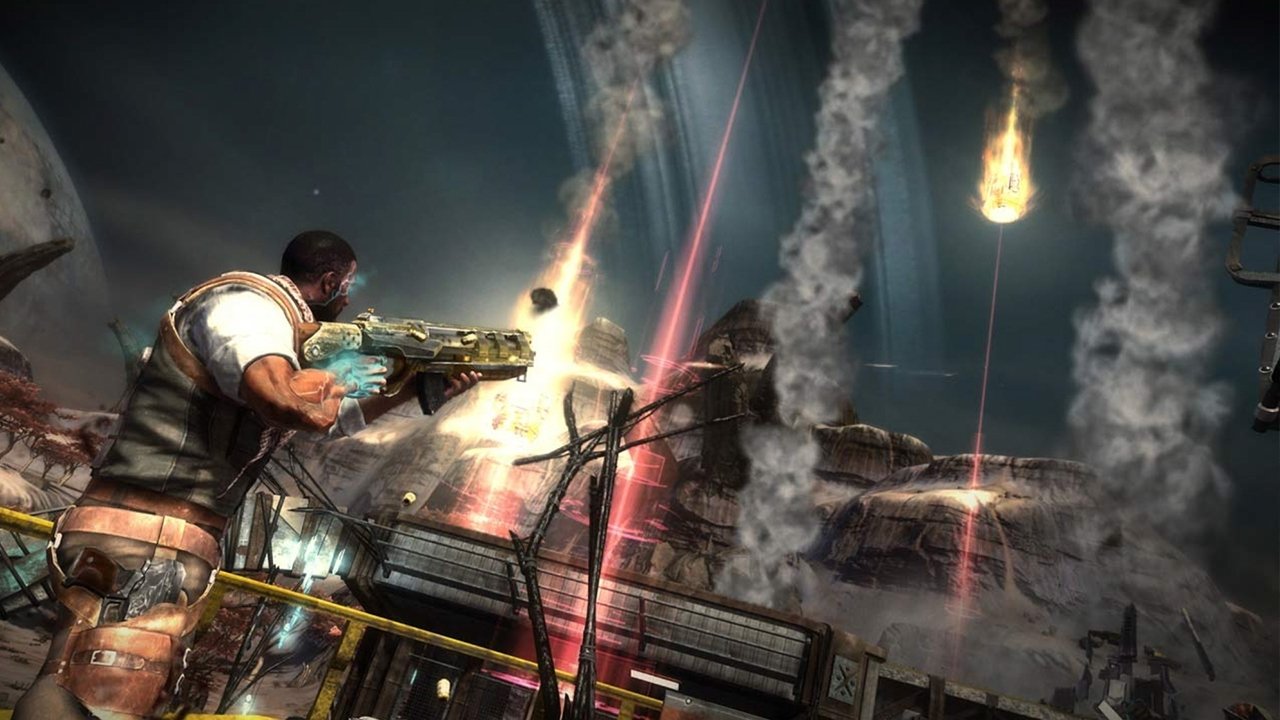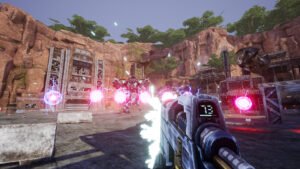Players can (literally) build their own battlefields in the spiritual successor to Warhawk.
I’ll start with a confession. I’ve never played Warhawk, so I didn’t have any expectations when Starhawk was first announced. That’s no longer the case in the wake of another E3. I had the opportunity to play through a Starhawk multiplayer demo while attending this year’s expo, and I walked away thinking that it’s one of the more intriguing titles in Sony’s upcoming lineup, even if the core mechanics are generally unremarkable. Starhawk controls like a standard third-person shooter and anyone familiar with the genre shouldn’t have any trouble picking up the basics.
It’s the variety – and the balance – that separates Lightbox Interactive’s latest project from everything else on the show floor. As you’d expect, Starhawk places a much greater emphasis on team play than most other multiplayer titles and consequently pushes you beyond the every-man-for-himself mentality. I stepped in for a game of 4 vs. 4 Capture the Flag and found that the squad-based tone makes your base feel like a safe zone that must be defended while a trip to the other side of the map is a trek behind enemy lines.
Beyond that relatively unique setup, the game does have a few purely mechanical innovations. When you die, you respawn as an escape pod in outer space that you can launch back towards the planet like a missile. More often than not, you’ll crash down uneventfully, but you can go after enemy soldiers in your base and hitting your target is a delightfully thrilling way to exact vengeance. It also makes it impossible to camp out at a respawn location, so the pods are an elegant solution to a rather irritating problem.
Unfortunately, I’m not as enamored with fighter jets/mechs that allow you to enter dogfights. The flight controls just aren’t intuitive enough to be immediately useful. I hadn’t even been airborne for ten seconds before I crashed into the side of a mountain and while that could be nothing more than a learning curve – the jets are astonishingly fast compared to everything else in the game – I’d still want to see some improvements before I get too enthused about the prospect of aerial combat.
Starhawk’s other gimmick is construction. Every kill nets you points that can be converted into turrets, walls, garages (they contain vehicles), and etc., and you don’t necessarily have to be the aggressor if you want to pad your wallet. If you build a turret, you’ll get credited whenever someone falls to that turret, so there are plenty of ways to stay competitive even if you’re not as skilled with a rifle as some of the other players.
Unlike the mechs, the build feature is incredibly easy to use. You’re probably not going to be erecting anything in the middle of a fight – you need to bring up a radial menu, select a structure, and then find an open tract of land to build on – but the system otherwise flows surprisingly well during gameplay. The entire process only takes a couple of seconds and buildings drop down in the blink of an eye, so you’ll get the benefits with minimal interruptions and the selection times will get even shorter once you’ve learned where everything is on the menu.
Getting back to the demo, I was playing with seven strangers in a noisy arena, so we were teammates only in the loosest sense of the term and our uncoordinated efforts might not be reflective of the battles that will eventually take place. Even so, Starhawk has enough flexibility to reward multiple styles of play and each role seems equally important. I spent most of my time gunning for the flag, so I’d hop in a jeep, grab the flag, and then race back, all while ignoring the chaos going on around me. Other people may have racked up more kills, but I know that I was at least a contributing member of the team and the options make the game feel refreshingly open-ended.
The game also encourages creative thinking in a way that rewards your ability to adapt to the environment. Our team picked up two quick scores in the early going, but both teams struggled once everyone became more familiar with the mechanics. The thing is, Starhawk’s Capture the Flag won’t allow you to score unless your flag is safely ensconced at your own base, so I took advantage of that wrinkle in order to ensure victory. As the timer ticked down to zero, I stood in our base with the enemy’s flag to protect a lead that was in jeopardy after our own flag was taken.
It almost felt like griefing because I was essentially playing not to lose, but that’s exactly what makes Starhawk so engaging. The battlefield conditions are always in flux, so you have to be able to counteract the maneuverings of your opponent and you have to prioritize (and defend) the strategic assets that matter at every stage of the game.
Of course, balance is crucial for a game with this much complexity, and there are some issues that still need to be sorted out. Our map was a bit too large for 4 vs. 4 – I went for long stretches without seeing any other people – and the dynamics seem like they would be radically different depending on the total number of players. I doubt I would have been able to camp with the flag during a full 32-person firefight, and there are so many variables that it’s virtually impossible to predict how the game will perform once it’s finished.
Fortunately, Starhawk won’t be out until 2012, so there’s plenty of time to make adjustments and Lightbox is aware of the challenges that lie ahead. I haven’t seen nearly enough to pass judgment on the game in its totality, but Starhawk nonetheless appears to have an enormous amount of depth and – like Warhawk – it should appeal to people looking for a multiplayer experience that isn’t Call of Duty.



